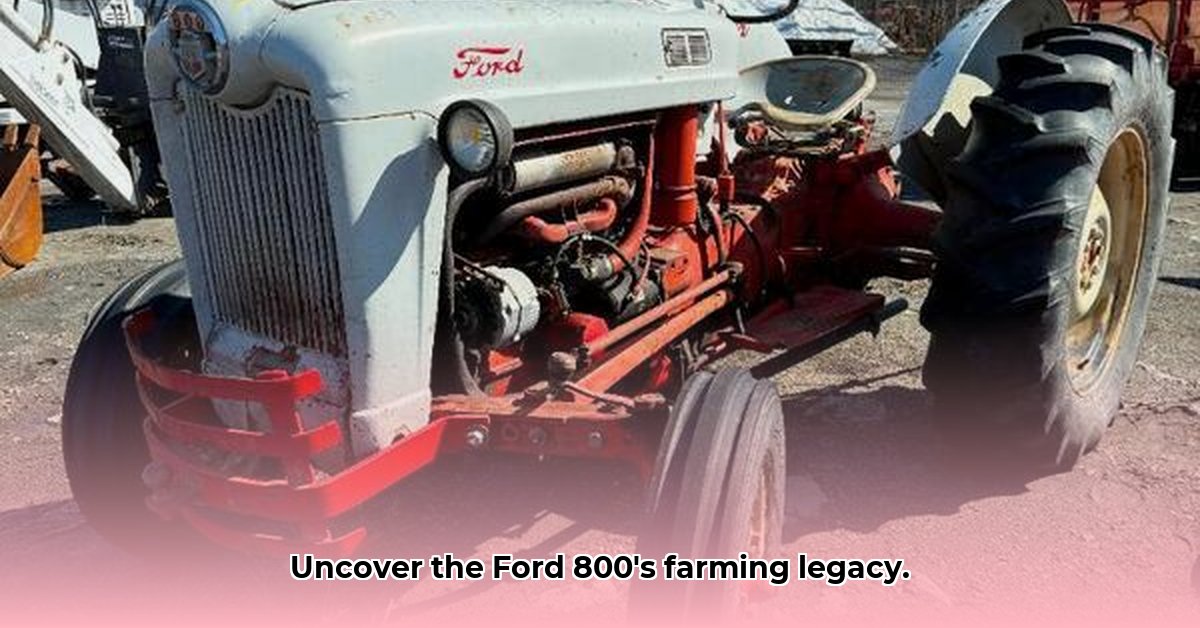
The Ford 800 tractor. The very name evokes images of sun-drenched fields and a bygone era of American agriculture. But beyond the nostalgia, what was its true impact on farming, and surprisingly, on sustainability? This isn't just a recounting of technical specifications (though we'll cover those as best we can), but a narrative exploring how this iconic machine shaped modern farming and its complex environmental relationship. We'll examine how the Ford 800 influenced farm size, efficiency, and labor, analyzing the resulting consequences—both positive and negative—for sustainable agriculture. We'll even attempt a comparison (with necessary caveats) to today's eco-friendly tractors. For more horsepower details, see this helpful resource: Ford 800 horsepower. Prepare for a journey through agricultural history, revealing the unexpected legacy of this farming icon.
The Ford 800: A Product of its Time
Imagine the American Midwest in the mid-20th century. Farmers faced monumental challenges: vast fields to cultivate, demanding harvests to meet, and a constant pressure for increased efficiency. The Ford 800 emerged as a key player in the ongoing mechanization of agriculture, a transition away from predominantly manual labor. This shift, however, introduced a new set of complex and unforeseen consequences. The Ford 800, in its own right, became a symbol of this profound transformation, profoundly impacting the landscape and the very nature of farming.
Uncovering the Elusive Specs: A Historical Investigation
Unlike modern tractors with readily available online specifications, precise data on the Ford 800 is notoriously scarce. Crucial information needed for a thorough sustainability assessment—fuel efficiency, emission levels, and manufacturing materials—remains elusive. This lack of readily accessible data significantly hinders a definitive environmental impact analysis. How can we accurately evaluate its environmental impact without the necessary quantitative metrics? This data gap underscores the critical need for further research into agricultural archives and historical records. A comprehensive lifecycle assessment, for instance, is urgently required.
Indirect Impacts: A Ripple Effect on Sustainability
Despite the limited precise Ford 800 specifications, we can still analyze its indirect influence on farming practices and, consequently, sustainability. The increased power likely enabled farmers to cultivate larger areas, significantly impacting land-use patterns. Did this lead to greater food production efficiency, or did it contribute to the expansion of large-scale monoculture farming, potentially harming biodiversity and soil health? This is a crucial question demanding further investigation, with implications for the sustainable management of agricultural land. Moreover, the widespread adoption of tractors such as the Ford 800 dramatically reshaped the agricultural labor landscape, shifting from primarily human-powered farming to a more mechanized approach. This social and economic transformation merits further scrutiny to fully understand the associated trade-offs.
Comparing Apples and Oranges: Ford 800 vs. Modern Tractors
Modern sustainable agriculture emphasizes minimizing environmental impact by prioritizing fuel efficiency, reducing greenhouse gas emissions, and using sustainable materials. How does the Ford 800 measure up? A direct comparison is challenging, if not impossible, due to the absence of complete specifications. However, the advancements in modern agricultural machinery are readily apparent. Consider the remarkable progress in emission control technology and the shift towards using more durable and recyclable materials. Contemporary tractors are designed with a significantly smaller environmental footprint in mind. This does not diminish the Ford 800's historical significance; rather, it highlights the remarkable progress in agricultural technology and its growing integration with environmental responsibility. But isn't it a compelling question to ask how much more fuel-efficient are modern tractors compared to the Ford 800, considering the improvements in engine technology?
A Call for Further Research: Filling the Knowledge Gaps
The story of the Ford 800 is far from complete. We need more data to fully grasp its environmental legacy. Imagine researchers carefully examining historical archives, poring over service records, and analyzing surviving tractors. This meticulous historical investigation is essential to gain a complete understanding. A comprehensive lifecycle assessment, analyzing the entire lifespan of the tractor from resource extraction to disposal, would prove particularly invaluable. Only through such dedicated research can we fully understand its role within the evolution of farming practices. Wouldn't this research contribute significantly to a more nuanced understanding of sustainable farming practices across time?
A Legacy in Perspective: Lessons from the Past
While precise Ford 800 specifications currently elude us, its impact on agriculture and the transition to mechanization remains undeniable. Its story underscores a crucial point: to truly assess the environmental legacy of agricultural innovations, we must place them in their historical context. The Ford 800 may not offer all the answers today, yet its study provides valuable insights into the ongoing journey towards more sustainable agricultural practices. Further research into tractors like the Ford 800 is vital to fully appreciating the impact of technological advances on our environment and food systems. The detailed investigation of its impact, considering both direct and indirect effects on the environment, would shed valuable light on the intersection of technology and sustainability in agriculture.